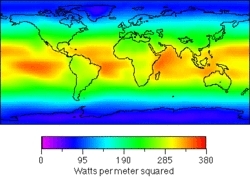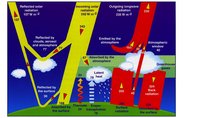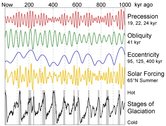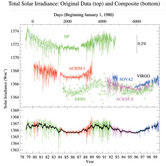Climate Literacy Handbook: Principle 1
| Topics: |
Previous: Guiding Principle for informed climate decision | Table of Contents (Climate Literacy Handbook: Principle 1) |Next: Principle 2
| Principle 1. The Sun is the primary source of energy for Earth’s climate system. |
Essential Principle 1 relates to the Earth’s energy balance and the physics and dynamics of the sun-Earth connection. The role of solar energy, first filtering incoming solar energy, then being absorbed by the land and water surfaces, then turned into infrared heat that radiates from the surface into space, is important for understanding the “greenhouse effect” whereby some of the outgoing infrared heat is captured by certain atmospheric gases, thereby warming the atmosphere.
|
Concept 1a. Sunlight reaching the Earth can heat the land, ocean, and atmosphere. Some of that sunlight is reflected back to space by the surface, clouds, or ice. Much of the sunlight that reaches Earth is absorbed and warms the planet. |
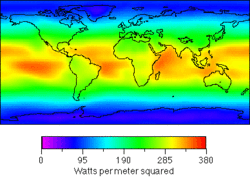 Figure 1: Annual (1987) pattern of solar radiation absorbed at the Earth's surface. (Image created by the CoVis Greenhouse Effect Visualizer).
Figure 1: Annual (1987) pattern of solar radiation absorbed at the Earth's surface. (Image created by the CoVis Greenhouse Effect Visualizer). The basics of the Earth’s energy balance have been understood for at least 150 years when John Tyndall began his studies to try to understand why the planet is not frozen solid. According to his calculations, the amount of incoming energy from the sun should be balanced by the amount of outgoing energy from the Earth into space, but those calculations suggested the Earth should be colder than it in fact is, so he began looking at other factors—examining whether some of the outgoing “dark rays” from the warmed Earth, what we now call infrared heat, was being trapped by trace gases. His research, first published in 1872, led to our understanding of what we now know as the “greenhouse effect”.
Tyndall understood that the incoming energy from the sun was inherently different from the outgoing heat from the warmed Earth. We now know that the atmosphere filters out many parts of the solar spectrum, and what does reach the surface of the planet is primarily short-wavelength ultraviolet and visible light. This energy is absorbed by the surface of the Earth and transformed into longwave infrared heat, which radiates back into space, except for a portion which is trapped by the gases that Tyndall became aware of through his studies.
Articles in Depth:
Teaching Aids and External Resources:
- Solar Radiation at Earth- UCARAn in-depth article written for teachers, from the University Center for Atmospheric Research (UCAR).
- Lesson: Atmospheric Processes: RadiationAn activity in which students investigate how different surfaces absorb heat and apply their experience with the surfaces to interpret real-world situations. Accompanied by a teacher's guide and background information, from UCAR.
|
Concept 1b. When Earth emits the same amount of energy as it absorbs, its energy budget is in balance, and its average temperature remains stable. |
The climate’s heat engine not only redistributes solar heat from the equator toward the poles, but also from the Earth’s surface and lower atmosphere back to space. Otherwise, Earth would endlessly heat up. Earth’s temperature doesn’t infinitely rise because heat is always radiating back to space. This net flow of energy into and out of the Earth system is Earth’s energy budget. When the flow of incoming solar energy is balanced by an equal flow of heat to space, Earth is in radiative equilibrium, and global temperature is relatively stable. Anything that increases or decreases the amount of incoming or outgoing energy disturbs Earth’s radiative equilibrium; global temperatures rise or fall in response.
Articles in Depth:
- Earth's energy balance
Teaching Aids and External Resources:
- Earth’s Radiation Budget- UCARA short article written for teachers, from UCAR
- Solar Energy and the Earth’s Energy BudgetAn in-depth article written for teachers, from the University Center for Atmospheric Research (UCAR)
- Climate and Earth's Energy BudgetAn article from the NASA Earth Observatory website.
|
Concept 1c. The tilt of Earth’s axis relative to its orbit around the Sun results in predictable changes in the duration of daylight and the amount of sunlight received at any latitude throughout a year. These changes cause the annual cycle of seasons and associated temperature changes. |
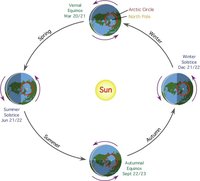 Figure 2: Annual change in the position of the Earth in its revolution around the sun. (Source: PhysicalGeography.net)
Figure 2: Annual change in the position of the Earth in its revolution around the sun. (Source: PhysicalGeography.net) The tilt of Earth's rotational axis and the Earth's orbit work together to create the seasons. As the Earth travels around the Sun, it remains tipped in the same direction, towards the star Polaris. This means that sometimes the northern half of the Earth is pointing towards the Sun (summer), and sometimes it is pointing away (winter). The points in the Earth's orbit when it is tilted most toward or away from the Sun are called solstices, and mark the seasons of summer and winter. When the northern hemisphere is tilted towards the Sun, the southern hemisphere is tilted away. This explains why the hemispheres have opposite seasons. Halfway in between the solstices, the Earth is neither tilted directly towards nor directly away from the Sun. At these times, called the equinoxes, both hemispheres receive roughly equal amounts of sunlight. Equinoxes mark the seasons of autumn and spring.
Articles in Depth:
Teaching Aids and External Resources:
- Seasons ReasonsContains an animation of the Earth from the perspective of the Sun's surface, illustrating how tilt changes over a year. From ScienceU.com.
- Animation: Seasonal SunlightAn animation made from a geostationary satellite's photos taken at the same time of day over a year, showing how the portion of the Earth in shadow changes. From the Naval Research Laboratory.
- Lessons: The Earth's OrbitEleven activities relating to the results of the motion and position of the Earth in its orbit, investigating both the causes and the effects of changing seasons. Designed to inspire learning about how to theorize, experiment, and analyze data. From the Smithsonian Institution.
- Global Energy Balance AnimationsAnimations showing seasonal (month-to-month) changes in longwave, shortwave, and net radiation across the globe, from the University of Wyoming & University of Oregon
|
Concept 1d. Gradual changes in Earths rotation and orbit around the Sun change the intensity of sunlight received in our planet’s polar and equatorial regions. |
The Serbian mathematician Milutin Milankovitch, began in the 1910s a series of astronomical calculations that demonstrated how Earth's orbital variations play a role in Ice Ages and other climate variations. Milankovitch cycles, such as precession of the equinoxes (23,000 years), obliquity (41,000 years) and eccentricity (100,000 and 400,000 year periods) influence climate change at long time scales, because they affect the amount of sunlight that radiates to Earth. They are measured using data derived from marine sediments, geomorphic features, loess, speleothems and astronomical observations and calculations. Understanding the Milankovitch cycles helps with reconstructing past climate variability at 100,000 year and longer time scales. At the present time, the Milankovitch cycles are at a point that place the Earth in an interglacial -- a warm period of relatively stable climate. This warm period is predicted to continue for tens of thousands of years, but is not expected to generate warmer climates over the period of decades. For this reason, recent climatic changes are not considered to be attributable to the natural cycles described by Milankovitch.
Articles in Depth:
Teaching Aids and External Resources:
- Climate TimelineInteractive resources allowing the exploration of current and paleoclimates using a powers of 10 approach. From NOAA.
- Orbital Variations
Article illustrating the three types of orbital variations characterized by Milankovitch
|
Concept 1e. A significant increase or decrease in the Suns energy output would cause Earth to warm or cool. Satellite measurements taken over the past 30 years show that the Sun’s energy output has changed only slightly and in both directions. These changes in the Sun’s energy are thought to be too small to be the cause of the recent warming observed on Earth. |
Could variations in the amount of energy from the sun alter climate? The short answer is, certainly. The concept that long term variations over thousands and millions of years of solar irradiance is born out in research. But scientists studying shorter term variations, including the 22 year solar cycle of solar activity measured between a minimum and maximum period, have determined that the amount of extra solar energy reaching Earth is relatively small, not enough to account for recent climate change.
Articles in Depth:
Teaching Aids and External Resources:
- Solar Variability: Striking a Balance with Climate ChangeNASA The sun has powered almost everything on Earth since life began, including its climate. The sun also delivers an annual and seasonal impact, changing the character of each hemisphere as Earth's orientation shifts through the year. Since the Industrial Revolution, however, new forces have begun to exert significant influence on Earth's climate. "For the last 20 to 30 years, we believe greenhouse gases have been the dominant influence on recent climate change," said Robert Cahalan, climatologist at NASA’s Goddard Space Flight Center in Greenbelt, Md.
|
|
